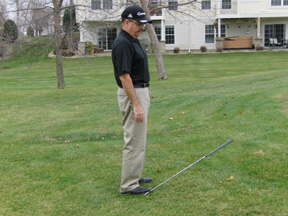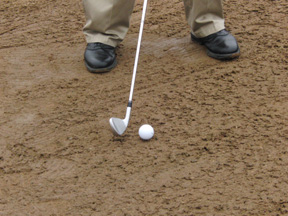Fairway Bunkers
By John Green
To an average golfer, a fairway bunker is an ultimate “That’s Golf” scenario because they land in them almost every round. And no, golf ball magnets are not buried under the sand as most golfers think they are! Usually they will resign themselves to a point where just getting their ball out in one shot is a major accomplishment.
But we need to think about more than just getting the ball out; we want the ball to travel some distance (it’s a fairway bunker, not a greenside bunker). For that to happen, two things you need to do: pick a correctly lofted club and making contact with the ball first.
Picking the correct lofted club means getting a club that you can hit the ball over the lip (edge) of the bunker in front of you. The problem the average golfer has is they may not have any idea how high their club will hit the ball. If this is you, do this simple test as shown on photo #2. By stepping on the clubface (not in the bunker), you can get an approximate trajectory of the ball. It’s a matter of picking the correct angle that will hit the ball high enough over the lip.
The thought process the average golfer has with this shot is to try to pick the ball off the sand. Picking the ball off the sand creates contact that is low on the clubface, which can result in a low trajectory ball flight (thin shot). If the bunker lip has any height to it, you’ll get to hit another bunker shot! Two things you must do to make contact with the ball first as shown in photo #3: play the ball back in your stance, and aim at the sand, just in front of the ball. I can’t stress enough how important it is to look at the sand and not the ball. This will ensure your clubhead will be traveling at a more downward angle at the ball; which will create a higher contact on the clubface and a better ball trajectory out of the bunker.
For more help with fairway bunkers see your local PGA or LPGA Professional.































